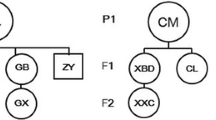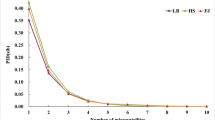Abstract
Microsatellites are playing an important role in paternity assignment of animals. Given the cost and effort, it would be optimal to develop a minimal microsatellite marker set for paternity testing. This study was the first to assess paternity in a captive colony of rhesus macaques (Macaca mulatta) from the Chinese province of Anhui using 10 polymorphic microsatellites. Results indicated that if at least 6 loci were genotyped, the probability of paternity assignment success was nearly 100%. Our results provide a panel of 6 markers that is effective for assessing paternity of subspecies M. m. siamica of Anhui origin.
Similar content being viewed by others
References
Sauermann, U., Nürnberg, P., Bercovitch, F., et al., Increased reproductive success of MHC class II heterozygous males among free-ranging rhesus macaques, Hum. Genet., 2001, vol. 108, pp. 249–254.
Lane, M.A., Mattison, J., Ingram, D.K., and Roth, G.S., Caloric restriction and aging in primates: Relevance to humans and possible CR mimetics, Microsc. Res. Tech., 2002, vol. 59, pp. 335–338.
Moore, T., Killiany, R., Rosene, D., et al., Hypertension-induced changes in monoamine receptors in the prefrontal cortex of rhesus monkeys, Neuroscience, 2003, vol. 120, pp. 177–189.
Barr, C.S., Schwandt, M.L., Newman, T.K., and Higley, J.D.E.E., The use of adolescent nonhuman primates to model human alcohol intake: neurobiological, genetic, and psychological variables, Ann. N.Y. Acad. Sci., 2004, vol. 1021, pp. 221–233.
Golos, T.G., Pregnancy initiation in the rhesus macaque: towards functional manipulation of the maternal-fetal interface, Reprod. Biol. Endocrinol., 2004, vol. 2, p. 35.
Wolf, D.P., Assisted reproductive technologies in rhesus macaques, Reprod. Biol. Endocrinol., 2004, vol. 2, p. 37.
Frankham, B., Ballou, J.D., and Briscoe, D.A., Introduction to Conservation Genetics, Cambridge: Cambridge Univ. Press, 2002.
Frankham, R., Genetics and conservation biology, Biologies, 2003, vol. 326, pp. S22–S29.
Abee, C.R., Mansfield, K., Tardif, S.D., and Morris, T., Nonhuman Primates in Biomedical Research: Biology and Management, Academic Press, 2012.
Williams-Blangero, S., VandeBerg, J.L. and Dyke, B., Genetic management of nonhuman primates, J. Med. Primatol., 2002, vol. 31, pp. 1–7.
Litt, M. and Luty, J.A., A hypervariable microsatellite revealed by in vitro amplification of a dinucleotide repeat within the cardiac muscle actin gene, Am. J. Hum. Genet., 1989, vol. 44, pp. 397–401.
Ellegren, H., Microsatellites: simple sequences with complex evolution, Nat. Rev. Genet., 2004, vol. 5, pp. 435–445.
Kayser, M., Ritter, H., Bercovitch, F., et al., Identification of highly polymorphic microsatellites in the rhesus macaque Macaca mulatta by cross-species amplification, Mol. Ecol., 1996, vol. 5, pp. 157–159.
Kanthaswamy, S. and Smith, D.G., Use of microsatellite polymorphisms for paternity exclusion in rhesus macaques (Macaca multatta), Primates, 1998, vol. 39, pp. 135–145.
Nair, S., Ha, J., and Rogers, J., Nineteen new microsatellite DNA polymorphisms in pigtailed macaques (Macaca nemestrina), Primates, 2000, vol. 41, pp. 343–350.
Newman, T.K., Fairbanks, L.A., Pollack, D., and Rogers, J., Effectiveness of human microsatellite loci for assessing paternity in a captive colony of vervets (Chlorocebus aethiops sabaeus), Am. J. Primatol., 2002, vol. 56, pp. 237–243.
Seyedabadi, H., Amirinia, C., Banabazi, M.H., and Emrani, H., Parentage verification of Iranian Caspian horse using microsatellites markers, Iran. J. Biotechnol., 2006, vol. 4, pp. 260–263.
Tian, F., Sun, D., and Zhang, Y., Establishment of paternity testing system using microsatellite markers in Chinese Holstein, J. Genet. Genomics, 2008, vol. 35, pp. 279–284.
Godavarthi, S., Jayaraman, A., and Gaur, A., Cross-species amplification of human microsatellite markers in pig-tailed and stump-tailed macaques, J. Genet., 2010, vol. 90, pp. 1–4.
Morin, P.A., Kanthaswamy, S., and Smith, D.G., Simple sequence repeat (SSR) polymorphisms for colony management and population genetics in rhesus macaques (Macaca mulatta), Am. J. Primatol., 1997, vol. 42, pp. 199–213.
Smith, D.G., Kanthaswamy, S., Viray, J., and Cody, L., Additional highly polymorphic microsatellite (STR) loci for estimating kinship in rhesus macaques (Macaca mulatta), Am. J. Primatol., 2000, vol. 50, pp. 1–7.
Hadfield, R.M., Pullen, J.G., Davies, K.F., et al., Toward developing a genome-wide microsatellite marker set for linkage analysis in the rhesus macaque (Macaca mulatta): identification of 76 polymorphic markers, Am. J. Primatol., 2001, vol. 54, pp. 223–231.
Rogers, J., Garcia, R., Shelledy, W., et al., An initial genetic linkage map of the rhesus macaque (Macaca mulatta) genome using human microsatellite loci, Genomics, 2006, vol. 1 p, pp. 30–38.
Penedo, M.C.T., Bontrop, R.E., Heijmans, C.M.C., et al., Microsatellite typing of the rhesus macaque MHC region, Immunogenetics, 2005, vol. 57, pp. 198–209.
Blanquer-Maumont, A. and Crouau-Roy, B., Polymorphism, monomorphism, and sequences in conserved microsatellites in primate species, J. Mol. Evol., 1995, vol. 41, pp. 492–497.
Garza, J.C., Slatkin, M., and Freimer, N.B., Microsatellite allele frequencies in humans and chimpanzees, with implications for constraints on allele size, Mol. Biol. Evol., 1995, vol. 12, pp. 594–603.
Crouau-Roy, B., Slatkin, M., and Freimer, N., A finescale comparison of the human and chimpanzee genomes: linkage, linkage disequilibrium and sequence analysis, Hum. Mol. Genet., 1996, vol. 5, pp. 1131–1137.
Brandon-Jones, D., Eudey, A., Geissmann, T., et al., Asian primate classification, Int. J. Primatol., 2004, vol. 25, pp. 97–164.
Kalinowski, S.T., Taper, M.L., and Marshall, T.C., Revising how the computer program CERVUS accommodates genotyping error increases success in paternity assignment, Mol. Ecol., 2007, vol. 16, pp. 1099–1106.
Rousset, F., GENEPOP’007: a complete re-implementation of the Genepop software for Windows and Linux, Mol. Ecol. Resour., 2008, vol. 8, pp. 103–106.
Jakabova, D., Trandik, J., Chrastina, J., et al., Effectiveness of six highly polymorphic microsatellite markers in resolving paternity cases inoroughbred horses in Slovakia, Czech J. Anim. Sci., 2002, vol. 12, pp. 497–501.
Chambers, K.E., Reichard, U.H., Möller, A., et al., Cross-species amplification of human microsatellite markers using noninvasive samples from white-handed gibbons (Hylobates lar), Am. J. Primatol., 2004, vol. 64, pp. 19–27.
Bradley, B.J., Doran-Sheehy, D.M., and Vigilant, L., Potential for female kin associations in wild western gorillas despite female dispersal, Proc. R. Soc. London, Ser. B, 2007, vol. 274, pp. 2179–2185.
George, D.D.P.F., Human short tandem repeat (STR) markers for paternity testing in pig-tailed macaques, HAYATI J. Biosci., 2007, vol. 14, pp. 39–43.
Farajallah, D.P., Human short tandem repeat (STR) markers for paternity testing in pig-tailed macaques, HAYATI J. Biosci., 2009, vol. 14, pp. 39–43.
Sherman, G., Kachman, S., Hungerford, L., et al., Impact of candidate sire number and sire relatedness on DNA polymorphism-based measures of exclusion probability and probability of unambiguous parentage, Anim. Genet., 2004, vol. 35, pp. 220–226.
Storz, J.F., Beaumont, M.A., and Alberts, S.C., Genetic evidence for long-term population decline in a savannah-dwelling primate: Inferences from a hierarchical Bayesian model, Mol. Biol. Evol., 2002, vol. 19, pp. 1981–1990.
Clisson, I., Lathuilliere, M., and Crouau-Roy, B., Conservation and evolution of microsatellite loci in primate taxa, Am. J. Primatol., 2000, vol. 50, pp. 205–214.
Kawamoto, Y., Kawamoto, S., Matsubayashi, K., et al., Genetic diversity of longtail macaques (Macaca fascicularis) on the island of Mauritius: an assessment of nuclear and mitochondrial DNA polymorphisms, J. Med. Primatol., 2008, vol. 37, pp. 45–54.
Kanthaswamy, S., Dollen, A., Kurushima, J.D., et al., Microsatellite markers for standardized genetic management of captive colonies of rhesus macaques (Macaca mulatta), Amer. J. Primatol., 2006, vol. 68, pp. 73–95.
Coote, T., Bruford, M., Human microsatellites applicable for analysis of genetic variation in apes and Old World monkeys, J. Heredity, 1996, vol. 87, pp. 406–410.
Numberg, P., Sauermann, U., Kayser, M., et al., Paternity assessment in rhesus macaques (Macaca mulatta): multilocus DNA fingerprinting and PCR marker typing, Amer. J. Primatol., 1998, vol. 44, pp. 1–18.
Author information
Authors and Affiliations
Corresponding author
Additional information
The article is published in the original.
Rights and permissions
About this article
Cite this article
Xu, Y.R., Li, J.H., Zhu, Y. et al. Development of a microsatellite set for paternity assignment of captive rhesus macaques (Macaca mulatta) from Anhui Province, China. Russ J Genet 49, 730–736 (2013). https://doi.org/10.1134/S1022795413070144
Received:
Published:
Issue Date:
DOI: https://doi.org/10.1134/S1022795413070144




